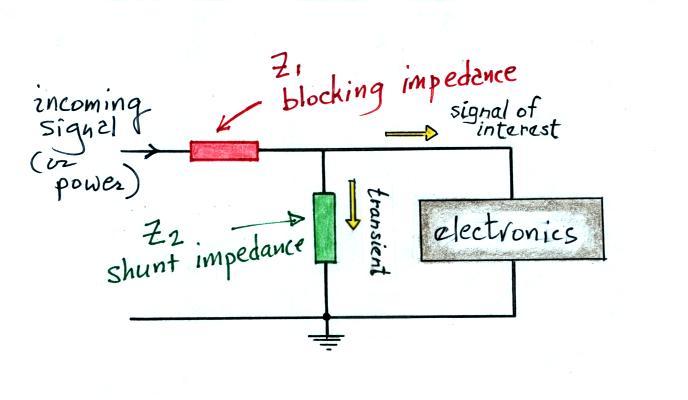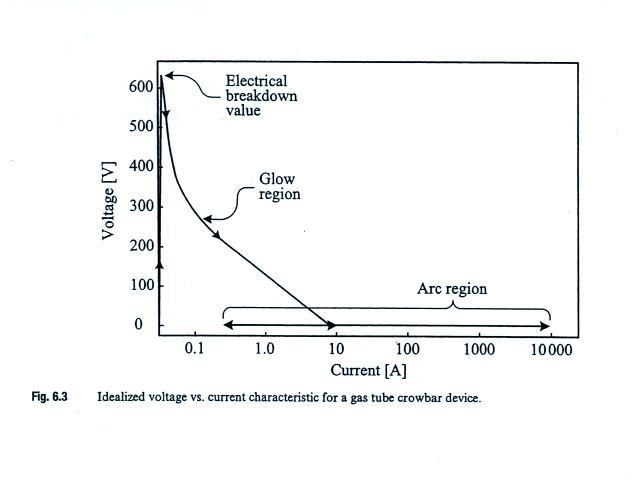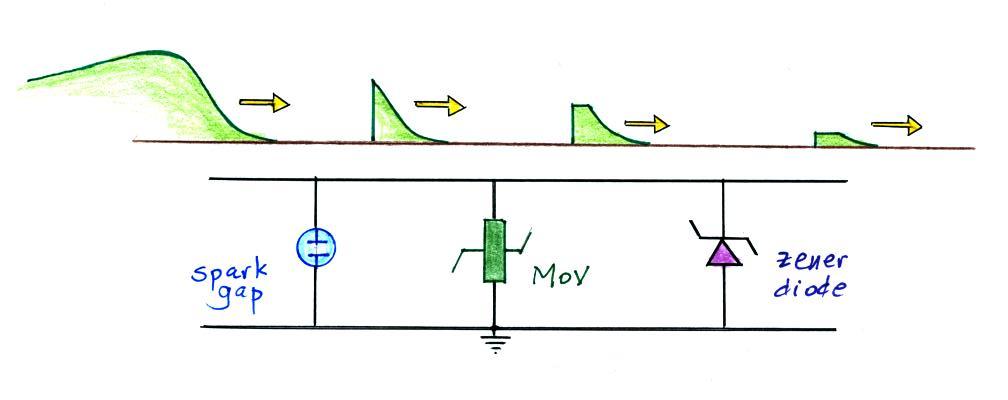What sort of an over voltage might you expect on an incoming power line? Uman addresses that question in his book "The Art and Science of Lightning Protection." Apparently the insulation levels on the AC wiring in a typical home are 5000 to 10,000 volts. This includes insulation on the wiring, in wall outlets, lamp fixtures, switches, and that sort of thing. So this is an upper limit, anything larger than this will breakdown the insulation and short to ground. In one respect the household wiring itself acts as a Surge Protection Device (SPD also formerly known as a Transient Voltage Surge Supressor). Transients on power lines are usually much lower, a few 100s of volts. In the upper 1% of cases overvoltages might range from 300 volts to a few 1000s of volts (the latter coming from a nearby strike).
One of the first protection considerations is the concept of topological shielding. This consists of nested enclosures that might each offer some degree of shielding. Incoming transients are reduced at the entrance to each successive enclosure. The idea is shown on the figure reproduced below (source: "Applications of Advances in Lightning Research to Lightning Protection," M.A. Uman, Ch. 5 in The Earth's Electrical Environment, National Academy Press, 1986. available online)

What might the transient protection
look like. In the most
general terms it will probably consist of a blocking impedance followed
by a shunt impedance.

The blocking impedance should
present a high impedance to the transient signal to prevent it from
reaching
the electronics. The shunt has a low impedance and will divert
the transient
signal to ground.
For the signal of interest, Z1 should appear as a low impedance. You might use an inductor if the incoming signal is low frequency (60 Hz power for example) and you want to block high frequency transients. If the incoming signal is high frequency, a capacitor would block low frequency transients.
The shunt resistance should appear as a high impedance for the signal of interest.
I have heard it is a good idea to provide an alternate path to an incoming signal that encounters a blocking impedance. I.e. something like the following:
For the signal of interest, Z1 should appear as a low impedance. You might use an inductor if the incoming signal is low frequency (60 Hz power for example) and you want to block high frequency transients. If the incoming signal is high frequency, a capacitor would block low frequency transients.
The shunt resistance should appear as a high impedance for the signal of interest.
I have heard it is a good idea to provide an alternate path to an incoming signal that encounters a blocking impedance. I.e. something like the following:

The first component is often a gas discharge tube.

A gas discharge tube or "spark gap"
is an example of a "crowbar"
device. It attempts to short circuit the signal (like
putting a crowbar across the signal
leads) once it exceeds a certain voltage
threshold. The figure below (from Uman's lightning
protection book) shows the operating characteristics of a typical gas
discharge tube.

The spark gap depicted here quickly
becomes
conducting once a voltage threshold of about 600 volts is
crossed. Spark gaps can carry large currents and are
bipolar. They turn on relatively slowly however (~1 μs).
Note that once created the arc discharge can be mainainted even at low
current levels. A device like this is sometimes difficult to
"turn
off."
MOV in the figure stands for metal oxide varistor. A varistor is a voltage-controlled resistor. The operating characteristics are shown below (again from Uman's book). Varistors are clamping devices which means they hold or limit the voltage to a particular value.

In the figure above, the varistor becomes active when the voltage across it reaches perhaps 180 volts (prior to that it has a large impedance). The voltage is then held at about that value until the current through the varistor reaches perhaps 100 A. A 200 v clamping voltage would be appropriate for a 110 volt AC power line. MOVs turn on very quickly (nanoseconds) and are bipolar. They do however have a relatively high capacitance and are not able to divert overvoltages for a sustained period of time.
The MOV could be followed by another shunt impedance such as a zener diode which would clamp the incoming signal to an even lower voltage. This is sketched below. Each device adds some additional attenuation of the transient signal.

MOV in the figure stands for metal oxide varistor. A varistor is a voltage-controlled resistor. The operating characteristics are shown below (again from Uman's book). Varistors are clamping devices which means they hold or limit the voltage to a particular value.

In the figure above, the varistor becomes active when the voltage across it reaches perhaps 180 volts (prior to that it has a large impedance). The voltage is then held at about that value until the current through the varistor reaches perhaps 100 A. A 200 v clamping voltage would be appropriate for a 110 volt AC power line. MOVs turn on very quickly (nanoseconds) and are bipolar. They do however have a relatively high capacitance and are not able to divert overvoltages for a sustained period of time.
The MOV could be followed by another shunt impedance such as a zener diode which would clamp the incoming signal to an even lower voltage. This is sketched below. Each device adds some additional attenuation of the transient signal.

Finally a few notes from the
chapter on medical issues and personal lightning safety in Uman's
lightning protection book.
Lightning deaths and injuries are probably underreported. There are about 100 people killed in the US every year by lightning and 1000 people are injured. This is more than for any other storm related phenomena except for floods.
The primary causes of death from lightning are cardiopulmonary arrest and damage to the central nervous system. I had always thought that someone struck by lightning would be seriously burned (internally and externally). This is apparently not the case, the duration of the lightning current is too short. Sometimes a person's clothing catches on fire, however, and that can cause serious burns.
A lightning strike can cause eye damage and hearing loss (one or both eardrums is(are) often ruptured). Psychological effects (anxiety, fatigue, chronic headaches or other pain, personality changes and depression) are apparently a significant and long lasting result of a lightning strike.
Telephone injury is the most common type of indoors injury associated with lightning.
I would encourage you to read "Updated Recommendations for Lightning Safety - 1998" by R.L. Holle, R.E. Lopez and C. Zimmerman if you ever find yourself in a situation where you might be responsible for providing lightning safety recommendations or warning to a group of people.
You should also be aware of the National Lightning Safety Institute , an organization that is dedicated to providing accurate lightning safety information and interested in lightning safety education.
Lastly I'll mention the The 30/30 Rule. Basically if there is less than 30 seconds between a lightning flash and the sound of the thunder, that lightning discharge is close enough to present a risk to you. You should be under cover. You should wait 30 minutes after the last lightning discharge from a thunderstorm before concluding that the storm no longer presents a lightning hazard to you.
Lightning deaths and injuries are probably underreported. There are about 100 people killed in the US every year by lightning and 1000 people are injured. This is more than for any other storm related phenomena except for floods.
The primary causes of death from lightning are cardiopulmonary arrest and damage to the central nervous system. I had always thought that someone struck by lightning would be seriously burned (internally and externally). This is apparently not the case, the duration of the lightning current is too short. Sometimes a person's clothing catches on fire, however, and that can cause serious burns.
A lightning strike can cause eye damage and hearing loss (one or both eardrums is(are) often ruptured). Psychological effects (anxiety, fatigue, chronic headaches or other pain, personality changes and depression) are apparently a significant and long lasting result of a lightning strike.
Telephone injury is the most common type of indoors injury associated with lightning.
I would encourage you to read "Updated Recommendations for Lightning Safety - 1998" by R.L. Holle, R.E. Lopez and C. Zimmerman if you ever find yourself in a situation where you might be responsible for providing lightning safety recommendations or warning to a group of people.
You should also be aware of the National Lightning Safety Institute , an organization that is dedicated to providing accurate lightning safety information and interested in lightning safety education.
Lastly I'll mention the The 30/30 Rule. Basically if there is less than 30 seconds between a lightning flash and the sound of the thunder, that lightning discharge is close enough to present a risk to you. You should be under cover. You should wait 30 minutes after the last lightning discharge from a thunderstorm before concluding that the storm no longer presents a lightning hazard to you.